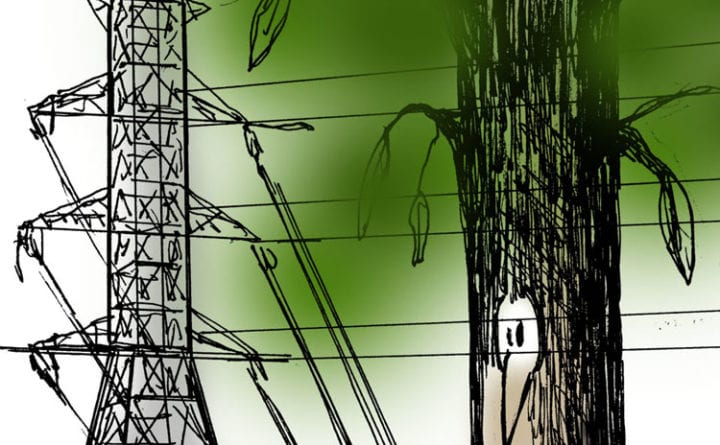
This op-ed by Maine Audubon Executive Director Andy Beahm and The Nature Conservancy in Maine State Director Kate Dempsey appeared in the October 16, 2018 edition of the Bangor Daily News.
Hydro line project doesn’t go far enough to mitigate conservation concerns
By Kate Dempsey and Andy Beahm, Special to the BDN – October 16, 2018 10:30 am
If there is a “heart of Maine” – an essential place at the center of our state’s history, economy and identity – it’s the North Woods. For generations, Maine’s productivity and character has flowed from our forests, the backdrop for our livelihoods and recreation.
But the significance of the North Woods goes well beyond that. It is the core of one of the world’s last remaining temperate mixed broadleaf forests (think forests that produce stunning fall foliage) and the largest connected forest in the eastern United States. It allows for the movement of wildlife throughout the Northeast – hosting migratory birds like the scarlet tanager and forest mammals like the American marten – and supports the last remaining stronghold of wild native brook trout in the country. The North Woods will only become more important in time, providing a key pathway for plants and animals to move as the climate changes.
Mainers have long understood that we must view any proposal that would substantially change the character of the North Woods with a highly discerning eye. Central Maine Power’s New England Clean Energy Connect (NECEC) transmission project is exactly that type of proposal.
Over the past several months, The Nature Conservancy and Maine Audubon have met frequently with CMP and its parent company, Avangrid, to learn about the proposal, share our concerns and provide recommendations for avoiding, minimizing and compensating for its projected impacts. We have examined it thoroughly, applying our scientific perspective and on-the-ground knowledge of Maine. Our hope throughout has been that, if the project proceeded, CMP could find ways to minimize and offset its environmental impact.
Unfortunately, our conclusion is that, as the proposal stands, CMP has not done nearly enough to address impacts to wildlife habitat.
The 150-foot-wide, 53-mile-long proposed new high-voltage corridor would result in a scar that fragments the North Woods from the Maine-Canada border to The Forks. Unlike traditional development that results in limited and isolated habitat loss – for example, a residential subdivision – linear projects like transmission corridors bisect the landscape, deterring the movement of certain animals across entire regions. Wildlife needs to move, and many species that live in forests avoid the open clearings under transmission lines. Over time, the cumulative impact of this permanent habitat barrier can be substantial.
It doesn’t have to be this way. Other transmission projects have proposed or implemented techniques to reduce habitat barriers and wildlife impacts. For example, Northern Pass in New Hampshire would have buried 60 miles of cable underground, and the proposed TDI Clean Power Link in Vermont is permitted to bury its cable for the entire 150-mile length of the line. Measures can also be taken to increase vegetation height in powerline corridors. Where habitat impacts can’t be avoided or minimized, compensatory measures can be taken to offset impacts – for example, by protecting and improving forest health near the transmission corridor.
The compensation plan CMP submitted to regulators in August falls well short of the transmission line’s projected impacts. Using standard mitigation principles, we conservatively estimate that 75,000-100,000 acres of permanent forest land protection in the affected region would be necessary to compensate for the project’s habitat fragmentation impacts. CMP’s current plan offers 2,000 acres in land conservation and required mitigation funding to address regulated resources like wetlands – essentially the minimum steps that can be taken to address state and federal requirements.
Simply stated, this project is out of balance. It would cause major, irreversible impacts to Maine’s North Woods, while offering very little in the way of measures to address or offset them. We firmly believe that the right balance must be struck.
Climate change makes this conversation all the more urgent. As New England states seek ways to rapidly reduce greenhouse gas emissions, Maine and its neighbors will face more proposals like the New England Clean Energy Connect.
It’s not an impossible tradeoff: we can address climate change while continuing to protect natural resources, wildlife habitat and rural communities. The first step is to make sure proposals to reduce emissions will in fact reduce emissions. If there are significant, verifiable climate benefits, renewable energy projects still must avoid and minimize on-the-ground impacts wherever possible and properly compensate for those that truly cannot be avoided.
The North Woods is the beating heart of Maine. It is a globally, regionally and locally significant resource for people and wildlife alike, essential to our way of life and irreplaceable. Let’s treat it with the respect it deserves.
Kate Dempsey is state director of The Nature Conservancy in Maine. Andy Beahm is executive director of Maine Audubon.
